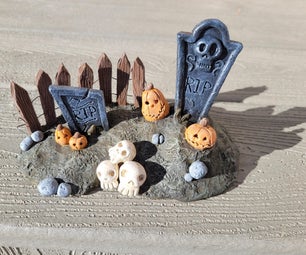Introduction: Mini Guillotine
What Halloween décor isn’t complete without a Guillotine? This 1/6 scale version could make a nice centerpiece to your decorations. Just like the Addams family!
I couldn’t find free directions online so I did my best job of reverse engineering and scaling a 1790’s French style Guillotine. Note that the blade is real and therefore it is dangerous (see video). Although I’m only using it to cut carrots and other vegetables, it could potentially do some serious damage to your finger! If you want a safe version, I suggest making the blade from wood or plastic and not including the weights.
Step 1: Tools/Materials
Tools:
- Table Saw
- Sander
- Drill Press
- Drill bits
- Wood clamps
- Nail gun (optional)
- Tape Measure / Ruler
- Pencil
Materials:
- 1x6 by 4’ long
- 5 1/2" x 1/4" by 2' long
- 1/4" dowel by 4"
- 1/2" dowel by 1"
- Eye hook
- Pulley (x2)
- String
- Gorilla glue
- Wood glue
- Stain (optional)
Step 2: Top Level
You will be building to this drawing. Note that the parts are color coded for easy reference.
Step 3: Base
The base is used to support the structure. You will build it to this drawing.
Step 4: Base Parts
The common wood size for this gillotine is 3/4" x 3/4". At this point, cut multiple strips from the 1x6.
I used a table saw with the blade height set to 3/8" to cut the notches in the 16" base parts. The feet are optional.
Step 5: Assemble Base
Attach the base parts as shown. I used glue for all connections.
Step 6: Table
You will build the table to this drawing.
Step 7: Table Parts
Cut the legs and supports to the lengths shown. Again, I used a table saw to cut the notches. Cut the table top from the 1/4" hobby wood.
Step 8: Leg Assembly
Build two leg assemblies as shown. Make sure the legs are perpendicular to the supports. I used glue and clamps for the attachment.
Step 9: Assemble Table
Assemble the table as shown. Glue was used for all attachments. I also used nails for the braces and top.
Step 10: Blade Assembly
At this point, you will need to make a decision (safe or dangerous). If you chose the safe route, make the blade out of plastic or wood. Do not sharpen the edge of the blade. The spacer and counter weight should also be made from a light weight material. The dangerous route shown here uses steel for the blade, spacer and counter weight.
Step 11: Blade Assembly Parts
Cut the slide as shown. Add a small guide hole for the hook. You can either drill the two 1/4" holes now or wait and do the entire stackup (slide, spacer, blade & counterweight) at once. I recommend the latter to guarantee pin alignment.
Step 12: Blade Assembly Parts - Spacer & Counter Weight
Both of these parts are made from the steel. I used 3 sheets of 1/16" for the counter weight since I didn't have any 3/16" metal available. Again, make a decision on the 1/4" holes.
Step 13: Blade Assembly Parts - Blade
Cut the blade as shown from a 1/16" thick sheet of steel. Again, make a decision on the 1/4" holes. Note that it's easier to sharpen the blade at this point. I used an edge grinder to sharpen the blade.
Step 14: Blade Assembly
Use the pins to line up all the pieces. Bond the pieces together with a glue that is suitable for all the materials. I used gorilla glue and clamps to ensure a tight joint. Add small hook to the top.
Step 15: Upright Assembly
You will build the upright assembly per this drawing.
Step 16: Upright Assembly - Sides
Cut two 3/4" x 3/4" pieces to 20" long. Add a 3/8" deep x 1/4" wide slot down the length. As with the earlier pieces, I used a table saw with a 3/8" blade height.
Step 17: Upright Assembly - Top Support
Cut the top support as shown. Note that I deviated from this drawing and used three 1/4" pieces instead of making the notches on the ends. Drill a 1/4" diameter hole through the center.
Step 18: Upright Assembly - Pulley Support
Make the pulley support from a 1 1/2" by 3/4" thick piece. Add chamfers as shown. Next, add the holes. For the last step, cut the slot to 3/4" deep.
Step 19: Upright Assembly - Head Stock
I made the two pieces by starting with a 4.75" x 1.625" piece of 1/4" wood. The 3/4" hole was drilled through the center. I then cut the piece in half to create two pieces.
Step 20: Upright Assembly - Bottom Support
I started with a 1" wide piece for the bottom support. However, after I noticed how force was applied to the bottom head stock, I modified this piece so it would make additional contact with the base.
Step 21: Pulley - 2 Options
I'm showing two pulley options. The first version uses a 1/4" dowel and a spacer from a old k'nex set. I didn't really care for this option since the string would catch between the spacer and dowel. For a second solution, I modeled a pulley and had it 3D printed at my local library. The total cost for two pulleys was $0.50. I've included the STL and STP files here in case you want to print your own.
Step 22: Upright Assembly
Think ahead at this point. Everything except for the pulley assembly will be installed as shown. You might have noticed that all the pieces have an interference fit. This is acceptable for the top/bottom supports and the lower head stock. You will need to do a little sanding but these pieces should fit together tightly. However, the blade assembly and upper head stock should be free to move up and down the sides. I hand sanded the groove until the blade assembly easily dropped down the sides. Once everything is working properly, glue it together and add the pulley support.
Step 23: Ready to Assemble
You should be ready to put it all together at this point.
Step 24: Table Install
Attach table to the base with glue and nails. Note the location shown in the picture.
Step 25: Upright Assembly Install
Secure upright assembly to the base and table with glue and nails.
Step 26: Braces
Add the four braces to add additional support to the upright assembly. I used glue and a nail gun to attach.
Step 27: String and Handle
I used a 1/2" diameter dowel cut to 3/4" long. A 1/8" hole was cut through the center with a 1/4" counterbore on one side. The counterbore allows for the knot to be hidden.
Tie string to the hook on the blade assembly. Feed string through the upper and pulley supports and down the other end of the pulley support. Cut string so that the handle is close to the brace when the blade is fully lifted.
Step 28: Sand and Finish
The entire guillotine was sanded to remove sharp edges and finished with Red Oak stain from Minwax.
Step 29: Final Product
Now your guillotine is ready for action.
Step 30: Scale
In case you were wondering about the scale of the guillotine...
Step 31: Table Side View
Step 32: Blade Up
No latch - just stuck like that for few seconds.
Step 33: More Pictures
Step 34: References
General Info:
https://en.wikipedia.org/wiki/Guillotine
Pictures:
http://www.guillotine.dk/pages/gallery.html
Full scale version (very similar build):

Participated in the
Halloween Decor Contest 2015















